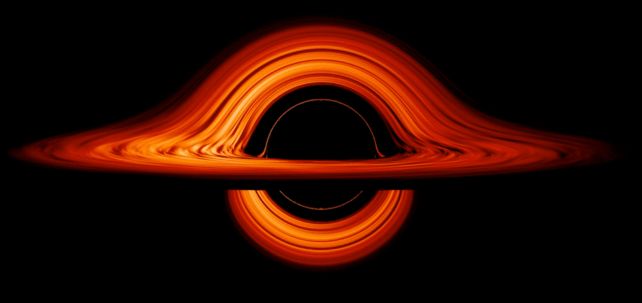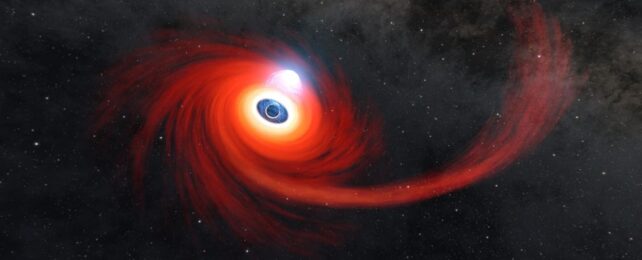From the far reaches of the observable Universe, astronomers have just seen a supermassive black hole suddenly flare to life.
The bright light blazing from 10 billion years ago suggests that the compact object abruptly started feeding on vast amounts of material. It is, scientists say, one of the most dramatic instances of this kind of event we've ever seen.
A team led by astronomer Samantha Oates of the University of Birmingham in the UK presented its discovery at the UK's annual National Astronomy Meeting. It will also be published in the Monthly Notices of the Royal Astronomical Society, and is currently available on preprint server arXiv.
The flaring event has been named J221951-484240, or J221951 for short.
"Our understanding of the different things that supermassive black holes can do has greatly expanded in recent years, with discoveries of stars being torn apart and accreting black holes with hugely variable luminosities," says astrophysicist Matt Nicholl of Queens University Belfast in Ireland.
"J221951 is one of the most extreme examples yet of a black hole taking us by surprise."

At the heart of every galaxy lurks a giant black hole, but they're not always active. Some – like the Milky Way's Sagittarius A* – are relatively quiet, with not enough material around them to feed at a significant rate.
But supermassive black hole activity varies on cosmic time scales; they switch on and off again as the material becomes available.
J221951 was discovered while Oates and her colleagues were looking for a different kind of transient flare; the glow of neutron stars merging in a kilonova event.
But in spite of being the right color, the signal from J221951 was the wrong duration. Kilonovae fade after a few days; J221951 lingered much longer.
The researchers looked more closely and discovered that the distance the light had traveled was much farther than they had initially thought: 10 billion years, as opposed to 500 million. The flare was traced to the center of a galaxy at that location in space and time.
This also meant that the flare was incredibly bright – consistent not with a single explosion, but the ongoing glow created by material swirling around the extreme environment outside a supermassive black hole as it falls onto it.
The suddenness of the flare, as well as the amount of light, also suggested that the black hole had abruptly started feeding in vast amounts of material, from a quiescent state to blazingly active.
There are two possible explanations for this. The first is that the black hole started feeding from material swirling in a disk around it that had finally drawn close enough for the black hole to slurp down, turning it into what is known as an active galactic nucleus. The second is more violent, when a star came too close to the black hole and was destroyed and accreted in what is known as a tidal disruption event.
Future observations will help the researchers discover which hypothesis is most likely.
"In the future we will be able to obtain important clues that help distinguish between the tidal disruption event and active galactic nuclei scenarios," Oates says.
"For instance, if J221951 is associated with an active galactic nucleus turning on we may expect it to stop fading and to increase again in brightness, while if J221951 is a tidal disruption event we would expect it to continue to fade. We will need to continue to monitor J221951 over the next few months to years to capture its late-time behavior."
The findings will be published in the Monthly Notices of the Royal Astronomical Society, and are available on arXiv.
